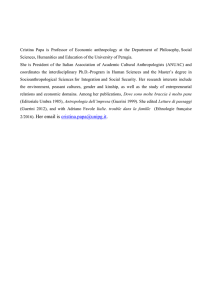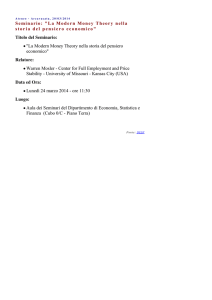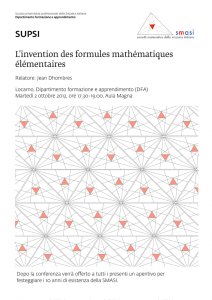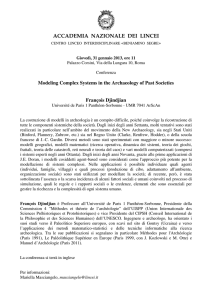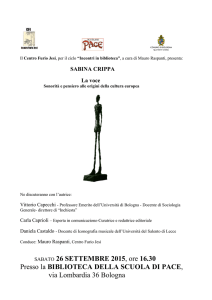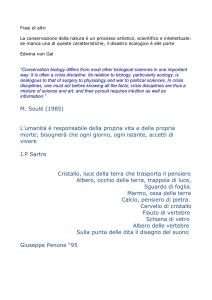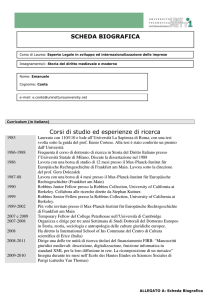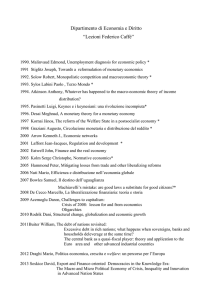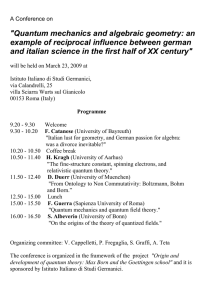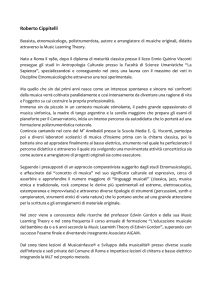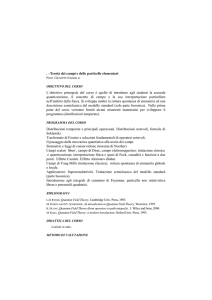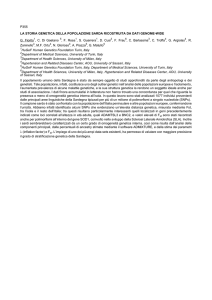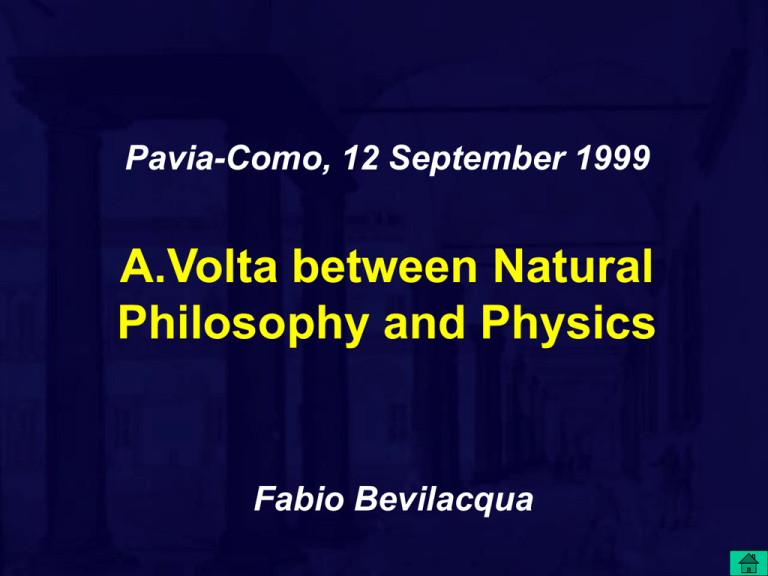
Pavia-Como, 12 September 1999
A.Volta between Natural
Philosophy and Physics
Fabio Bevilacqua
Contents
1) Introduction (13)
8) Debate w. Coulomb (12)
2)Travelling and
Corresponding (8)
9)Factorisation (25)
3)Cultural and Scientific
Context (4)
4)The Roots of Volta’s
Research Program (9)
5)Debating with
Beccaria (4)
10) Debate w. Galvani (28)
11) Final steps (6)
12) Volta’s theoretical
legacy (5)
13) Primary Sources (6)
14) Historiography (6)
6)New Researches (4)
15) Celebrations (6)
7)Electrostatics (4)
16) Volta on the Web (2)
Alessandro Volta (1745-1827)
Theory and experiments
A.Coulomb
A.Volta
L.Galvani
Extraordinary Life on the
European stage
• Religious family; early
extensive scientific
correspondence; no
university education;
• University chair at 33
extensive travelling;
rich sentimental life;
Copley medal
Closely witnessing revolutionary
changes
• What was going on? The revolution in physics
was matched by a political one
– A period of enlightened reforms was followed by a
revolution, a new empire, the restoration
Enlightened Despotism
A tenure for the quantifiers
• Austrian Reforms: Pavia University and the
professionalization
of
the
Baconian
sciences:
• Scarpa, Spallanzani, Scopoli, Brugnatelli,
G.Fontana, M.Fontana, Frank, Brunacci
1778: Volta’s chair in
experimental physics: cabinet
and theatre
Napoleon’s military tourism
L’Institut reopens
Volta and Napoleon
• 1796: The battle of Lodi (near Pavia)
• 1801: Institut de France
Institutional changes
• Mathematising the Baconian sciences: Paris
• Research and teaching: Berlin
The Context: Institutional
1815: Restoration
Travelling and Meeting:
1777 and 1787, Switzerland
• Voltaire, Senebier, de Saussure
• Genêve, Basel, Strasbourg, Berne
Sept. 1781-April1782:
Switzerland, Pays Bas, France
• September: Genêve
• October: Paris
• November: Bruxelles, meeting Magellan
• November: Antwerp, The Hague
• 28 November: Harlem, meeting Van Marum
• Back to Paris
December 1781- April 1782: Paris
• Lavoisier, Laplace, Franklin, Buffon, Sage,
Le Roy
• Synthesis of water
April-June 1782: Great Britain
• Meeting Magellan in Bruxelles, Louvain and
then London; June: Bristol
• Birmingham: Priestley, Boulton and Watt
July-November 1784: Wien,
Berlin, Goettingen
• Wien: Joseph II
• Helmstaedt: Crell
• Brunswick: Duchess (mother)
• Goettingen : October, Lichtenberg
• Gotha: Duke and Prince
• Genêve: Tissot, Saussure
1801-2: Paris, Lyon, Genêve
• Paris: Bonaparte, Chaptal, Berthollet,
Fourcroy, Guyton, Laplace, Seguin, La
Metherie
• Lyon: Chaptal
Corresponding
• Priestley, Franklin, Nollet
• Van Marum
• Lichtenberg
• Magellan
• Gren
• Banks
1763: An early start
Joseph Priestley
Gianbattista Beccaria
Jean Antoine Nollet
A closer look at the scientific
context
• Classical and Baconian • Two epistemological
criteria: sensible and
• Old “classical” matheoccult (medieval);
matized sciences: meprimary and secondary
chanics,
astronomy,
(Galileian)
optics, harmony (fisica
generale: quadrivium)
• Three traditions of
natural philosophy in
• New “baconian”
the classical fields:
experimental sciences:
electricity, magnetism,
thermology, chemistry
(fisica particolare
(experimental))
Baconian electricity
An older epistemological context
• Scholastic epistemology: sensible versus
occult qualities
• Quantification of sensible qualities through
intensive and extensive factors
• Galileian epistemology applied in Classical
Sciences: primary (quantifiable) and
secondary (non quantifiable) qualities.
Problem: often primary are “occult”
• Baconian Sciences: still sensible versus
occult. Problem: first make it sensible
A wider cultural context:
Descartes
Newton
Leibniz
Volta’s Research Programme
• The received view
• A hint
• Origins
• Theoretical works
The Received View
• Classical sciences (general physics,
quadrivium) challenged by
• Baconian Sciences (particular, experimental
physics)
• undergoing a process of quantification and
mathematization along NewtonianCoulombian lines
• Enlightenment and quantification
• “Standard Model” of particles and fluids and
interactions
The Roots of Volta’s Tension
• A hint from Massardi, Volpati, Polvani:
• Use of intensive (non additive) and
extensive (additive) factors, like temperature
and heat
• My approach: We cannot confine ourselves
to models and analogies
• General regulative principles have to be
taken in account
Origins: Oresme
• Oresme: “latitude referring to the intensity of a
quality or motion and longitude to its extension
either in the qualified body or mobile or in time”;
“Oresme also differed from his Oxford
predecessors in that his primary measure of
qualities and motions became not intensity,
pure and simple, or velocity, pure and simple,
but the so-called "quantity of quality” or
"quantity of motion," where the quantity of a
quality or motion was equal to its intensity times
its extension”
Origins: Oresme
• “To consider such a quantity of quality or motion
was an important step away from the ideas of
the Oxford authors, for whom the product of an
intensity times an extension had no real
ontological significance; In the decades after
the appearance of the works of Heytesbury
Swineshead, and Oresme, discussions of the
intension, remission, latitudes, and degrees of
forms were quite common, and many rather
elementary handbooks of the basic concepts of
their works were compiled”
Origins: Leibniz
• “Per dare un saggio delle mie concezioni mi è
sufficiente spiegare che la nozione di forza o
virtù, che i Tedeschi chiamano Kraft e i Francesi
force, e per esporre la quale io ho elaborato
una scienza particolare della dinamica,
chiarisce di molto la comprensione del concetto
di sostanza. In effetti la forza differisce dal
concetto di mera potenza così familiare alla
Scolastica in quanto questa potenzialità o
facoltà non è altro che una possibilità pronta ad
agire, la quale necessita,
Origins: Leibniz
• però, di un'eccitazione o di uno stimolo esterni
per poter passare all'atto. Ma la forza attiva
contiene un certo atto o entelechia e si trova a
mezza strada tra la facoltà dell'agire e l'azione
stessa; essa implica lo sforzo, e così passa di
per se stessa all'operazione; nè ha bisogno di
alcun ausilio ma semplicemente della rimozione
dell'impedimento”
The Context: Scientific
Origins of Volta’s Theory:
Beccaria
Volta’s Theory: 1769 De Vi
• l'attrazione del fluido
elettrico ...non segue
quella attrazione
universale
proporzionale alla
massa e decrescente
secondo il quadrato
delle distanze
• ad una notevole
distanza
Volta’s Theory: 1769 De Vi
• il fuoco sovrabbondante, cioè tutto quello
che supera la saturità rispettiva, deve
trasmettersi agli altri corpi coi quali
comunica, affinché si conservi l'equilibrio
delle forze
• il fuoco sovrabbondante da questa entra in
quello, in ragione della sua capacità
• sebbene vi tenda con grande sforzo
Volta’s Theory: 1771Novus
• forze mutue... non
meccaniche
• all’accumularsi di una
certa quantità di fuoco
estraneo in una delle
facce, altrettanto fuoco
nativo si sforza di
allontanarsi da quella
opposta
• ricavavo felicemente
anche tutti i fenomeni
dell’atmosfera elettrica
1775: Electrophorus
1776: Methane
1777: Inflammable air pistol
1777: Inflammable air eudiometer
1778: Chair at Pavia University
Volta’s Theory:1778 De Saussure
• "quanto più d'azione e di giri della macchina
accade d'impiegare per far salire il pendolino ad
una determinata tensione, tanto maggiore vuol
dirsi che sia la capacità del conduttore"
• "Non c'è altra energia che
quella che chiamo tensione
di elettricità , che è poi lo
stesso sforzo di spignersi
fuori
Volta’s Theory: 1778-80
Sull’elettrometria
• si forma d'attorno a
quel corpo così
elettrizzato
un'atmosfera attiva,...
estendendo a
considerabile distanza
una cotal forza o
potenza, per cui
qualsiasi altro corpo
immerso in cotesta
sfera di attività ne
viene più o meno
affetto
1780: Condenser Electroscope
1782: Q=CT
Volta and Coulomb:Force and
Tension
Coulomb’s 1785 Newtonian force
law: The Torsion Balance

